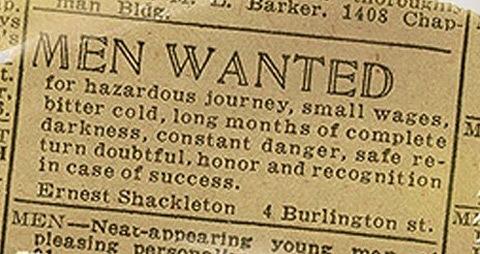Picture seeing an online dating profile like this:
Requirements:
- Must do all chores (laundry, all cleaning, bills), plus more as needed.
- Must be willing to make sandwiches on demand and cook all meals 5+ times per week.
- Minimum 700+ credit score and excellent budgeting skills required.
- Must be able to handle difficult in-laws.
Who would swipe right on a profile like that? Any sane suitor would swipe left on that person as if their life depended on it because no one in their right mind would list requirements like that on a dating profile. It just isn’t a feasible way to find a successful match. So why are job ads being written like this?
Take a look at the description below, taken from real job postings:
Requirements:
- Minimum 10 years of experience.
- MBA required.
- MUST be willing to work long hours on nights and weekends.
- Must handle all regular duties plus others as needed.
- Self-starter who can work with minimal direction.
- Proven success in consistently landing top-level enterprise clients.
- Natural ability to thrive under high pressure.
- Please do not apply if you do not have qualifications listed above.
More like a prison sentence than a job ad. Not a single top performer would be tempted to apply to a job like this, and yet this continues to be the standard in the job ad world. Instead of showcasing a company’s passion, mission, and opportunity, they aim to scare off all but the most dedicated candidates. Demanding job ads became the norm during the 2008 financial crisis. Job ads were full of intimidating lists of hefty requirements, because the labor market was so bad that even top people were willing to take any jobs they could get.
The trouble is, this approach has stopped working.
The economy has shifted to a candidate-driven market, and companies are finding that the talent market is more competitive than ever, especially in fast-growing market segments like emerging technology, wireless/telecom, and programming. And due to tightening work visa restrictions, employers cannot always rely on the pool of H-1B workers. As a result, companies are having a harder time attracting talent.
Better to have too many choices than not enough.
Of course, there are some non-negotiables in both dating and employment. Everyone has standards. But highlighting the negative aspects of the job to “scare away” unmotivated applicants will make a top candidate question why they would bother applying to an apparently horrible job.
Experts estimate that up to 80% of candidates are passive. This means they keep options open but usually stay put unless something great comes along. Companies who write hardline job ads cut out 80% of their possible applicants. The best employees almost never have to make a career move, so companies with bad job descriptions automatically eliminate the best candidates right off the bat.

Image: Ernest Shackleton’s 1901 newspaper ad for the first successful trip to the South Pole.
Writing more attractive job ads will naturally cause an uptick in the number of applicants. Sometimes this is the reason companies write harsh job ads – they want to reduce the flood of applications. However, this strategy is flawed. In the world of easy online applications, companies who demand too much will still get flooded with applicants, but the majority will be desperate or underqualified applicants. It is better to have too many choices than not enough.
By the way, getting overwhelmed by applications is one of the best reasons to consider using a recruiter to weed through hundreds of applicants. Recruiter fees are expensive, but so is a hiring manager’s time.
Bad attitudes are expensive.
Focusing on the minimum qualifications is insulting to top candidates who have worked hard to build their skillset and bring extra to the job. Telling someone that they have met the minimum standard is hardly motivating in the dating world, and even less in the professional world. It is far better to tell them what the reward will be if they exceed expectations. Instead of focusing on the minimum bar, focus on the things that will set the job apart and how the company rewards its best people.
If employees have to jump through hoops during the hiring process, expect to pay a lot more than market rate to attract high-performing employees. Even then, many people will eventually leave a high-paying job for a job that treats them well. High turnover might work for minimum-wage employees, but it gets very expensive for salaried employees. Consider the direct costs of replacing an employee (advertising the job, interviewing, travel costs, background checks, and onboarding), plus the indirect costs of low morale, poor branding, decreased service quality, and the negative effects of stressed and dissatisfied employees.

Just like in real life, there is a spectrum of what works. Antagonistic, authoritarian work relationships can sometimes produce results (take Amazon’s notorious work culture, for example), but candidates in today’s market have lots of options. Companies who take a hardline attitude should not count on attracting top performers.
Show personality, not gimmicks.
Once upon a time, “Coding Ninja” job titles and ping-pong tables were the hottest way to attract up-and-coming talent. It worked for a while, but in the end, employees mostly want to make sure that a job will meet their real needs. That means money, time off, career advancement, and a good workplace environment.
What should companies focus on instead? Start with opportunities, rewards for top performers, career paths, benefits, work culture, and brand ideals. The top attractors in the United States have strong branding around how they’re changing the world. They don’t always pay the most or have the best benefits, but they maintain strong ideals about their mission.
Most companies only put effort into considering what they want out of an employee, and no time thinking about why anyone would want the job. This is unfortunate, because every company has something unique to offer. Start with the hard numbers, like salary package, benefits, PTO, and bonus structure. Go on Glassdoor to see what people are already saying, and pick out some of the top positive comments describing the culture. Plan out the realistic career path for the person who will fill this position, and note in the job description what opportunities they will have.
Focus on the relationship.
Even the most formal professional relationships are still relationships. They are based on people understanding each other and cooperating. When someone takes a job, they sign up to spend hundreds or thousands of hours of their life to pursue the company’s goals, and the company agrees to be that employee’s livelihood.
Investing in employees is expensive, but it also produces great results. Many studies have shown that unhappy employees do a bad job at work, and happy employees give better service. It takes time, effort, and hard work to attract top people, but the payoff is enormous.
Want more tips on how to write a great job ad? Check out Blue Signal’s top 5 tips for building a better job description.

